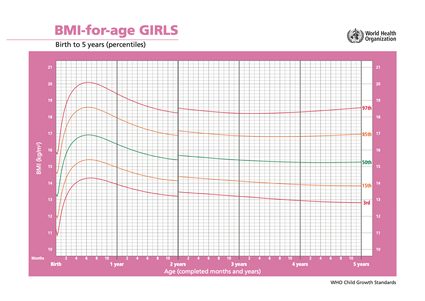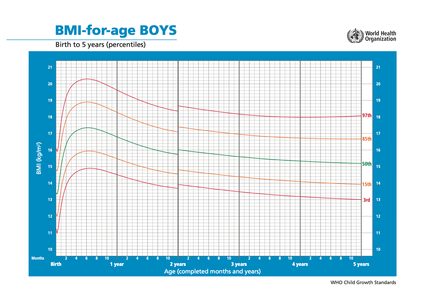BMI Percentile Calculator
If you're concerned about your child's growth, use this BMI percentile calculator for children and teens. If you don't know your child's BMI, this tool also has a built-in child BMI calculator. This information will help you to interpret pediatric growth chart (both BMI charts for teens and BMI charts for kids). That's not all - in the article below, we explain how BMI classifications work and why is it essential to keep an eye on the kid's growth chart.
If this topic is interesting to you, feel free to take a look at our head circumference percentile calculator, which is handy in determining a child's rate of growth.
We try our best to make our Omni Calculators as precise and reliable as possible. However, this tool can never replace a professional doctor's assessment. All information on this website is for informational purposes only and is not intended to serve as a substitute for medical consultation. Always consult your results with a health care provider.
How to calculate BMI?
BMI stands for Body Mass Index, which can be easily calculated with just body mass and height
-
Get your body mass and height.
-
Use the BMI formula:
BMI = body mass / height². -
Substitute the values and calculate.
Weight and height must be in SI units (kilograms and meters, respectively), as the BMI units are kg/m2.
Remember that you can switch between the units directly in our BMI percentile calculator.
What is BMI classification?
Child BMI charts differ from adult BMI classifications. First of all, you don't read the BMI score directly but have to interpret a special pediatric growth chart (or use our BMI percentile calculator) to know between which percentiles your child places. You can also check the BMI calculator for kids.
This is because the BMI of a still-growing prepubescent child may be unreliable - they tend to grow quickly, so their BMI becomes extremely inaccurate. On the contrary, during puberty, teens quickly gain weight, especially girls - and so their BMI increases. If a child is athletic, their BMI might be higher and potentially inaccurate, as muscles weigh more than fat. There's a special bmi calculator for teens, as the adult norms are inadequate for the changing bodies.
Why is the child's BMI chart useful?
The pediatric growth chart quickly alerts us to any signs of developmental disorders. There are some thresholds that we need to be aware of so as to react appropriately. An important information is a sudden change in the percentile lines (two or more channels) - in such case, you should visit a doctor immediately.
The BMI percentile calculator in practice
Let's explain how to use this kids growth chart calculation:
- First, give us some details:
- Age of your child - to one week (if less than 13 weeks old) or one month (if older).
- Whether they're a boy or a girl.
- Fill in the BMI of your child. You can also calculate his/her weight and height using the built-in BMI calculator for kids.
Get the results - between which percentiles the child fits into.
In the next paragraph, you can read more about the interpretation of BMI classification.
How to interpret BMI chart for teens/kids?
Once you input all the information needed into this BMI calculator for kids, you'll see some numbers as a result. As mentioned above, the first is the exact percentile result. Just below that is the range in which your child places, e.g. between the 15th and 50th percentile.
The most important aspect of BMI percentile charts is that they enable the doctor to monitor the child's growth. However, they are only partial information, and the patient has to be assessed as a whole.
It is acceptable when a child grows along similar percentile canal and the results from other measurement charts are consistent. Similar in the sense that there are no noticeable variations in the charts for height, weight, BMI, and head circumference. A child may be small and stay below 15th percentile all the time and be perfectly healthy at the same time. However, a difference of more than two canals should cause concern and require an urgent pediatrician consultation.
Doctors consider the rate of growth as an important factor when looking at a pediatric growth chart:
- On average, the child should follow a similar percentile line on the chart as they grow.
- If the results cross two or more percentile lines (they raise/decrease by at least two ranges), e.g., from the 75th-85th percentile to the 15th-25th percentile, you should consult a doctor.


Our data is derived from WHO (World Health Organization), and the standards were developed using data collected in the WHO Multicentre Growth Reference Study. We based on the expanded tables for girls and boys from birth to 19 years. The calculations are estimated for the month of age, and not detailed to weeks.
FAQs
What's BMI percentile?
BMI percentile refers to a child's BMI compared to a similar group of children of the same age and gender. Since weight and height change rapidly during growth, relying exclusively on a child's BMI is not an accurate indicator. Therefore, it’s essential to understand a child's BMI in relation to their peers of the same age and gender.
What's the BMI percentile of a 137 cm tall boy weighing 33 kg?
For an 11-year-old boy, his BMI percentile is 61.37, indicating he falls between the 50th and 75th percentile. Percentiles between the 5th and 85th are considered within the healthy weight range.
To determine this value, follow these steps:
-
Determine the child's BMI using the BMI formula in SI units:
BMI = body mass / height2
BMI = 33 kg / (1.37 m)2 = 18.
-
Look for a BMI chart for boys.
-
Plot the point on the chart based on the age and calculated BMI.
-
Identify the corresponding percentile.